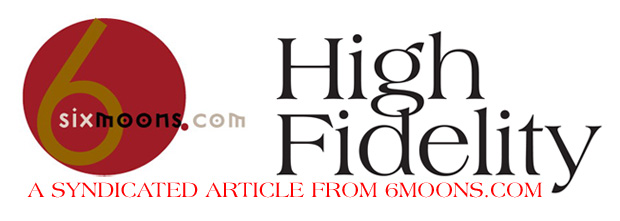 This review first appeared in the 6Moons.com magazine. You can also read this review HERE in its original version. We publish this article in a mutual syndication arrangement with publisher Srajan Ebaen. Everyone can write to him – if you have questions or wish to send feedback – you’ll find an e-mail address under his name. All images contained in this review are the property of 6Moons.com. - Ed.
Reviewer: Srajan Ebaen  How small is too small? The MiniWatt tube integrated from Hong Kong does beg the question. I can't vouch for its claim of "world's smallest 4-tube amplifier". Greatech's uVac valve unit too is tiny. But clearly, the MiniWatt makes the very short list of contenders. What exactly is appealing about being crowned king of that Lilliputian domain? I'm not sure. I can tell you how such extreme compaction has been accomplished here. It involves an unusual marriage. Think in-house developed switch-mode power supply or SMPS. Then add a transformer-coupled, military-grade Chinese NOS 6J1 (pentode) and 6P1 (triode) single-ended circuit. From this follow two relevant specs. One, input voltage is flexible. To be exact, it's 85-132VAC or 176-265VAC. That promises greater than usual immunity to under/over voltages. Plus, no power transformer hum. Two yeahs for sure. Two, 8-ohm power output is 2.5 watts. Off the bat, that's not exactly confidence inspiring. It turns the cute footprint of 130 x 100mm and attendant weight of 1.5kg into secondary attention grabbers. Anyone serious about bang for the buck won't obsess about breaking miniaturization records. Who cares about being king of the dwarves? One wants raw performance. 2.5 watts seem more raw deal than muscle. This ain't no portable iPod audio machine even though pricing should appeal to the same core demographic. Alas, what does the average iPod punter know about real rather than bullshit power requirements? Exactly. So the MiniWatt really arrives with a chip on its shoulder. It's got a built-in perception barrier like a big red stop sign. Nay then? Not so fast.  Claimed frequency response is 30Hz to 20kHz within a 1dB window, residual noise is less than 0.8mV. The EI output transformers are Japanese issue. After perhaps a solid "wow, cute" exclamation, the next response any thinking man and woman will level against this proposition has got to be "why bother? What could one possibly do with 2.5 silly tube watts?"  Derek, director of business development at MiniWatt, is prepared to hit that question on its pin head. His website sports a brief introductory video. In it the MiniWatt drives MBL 116 speakers with Burmester's 061 CD player as source. While the delivery medium of proof is completely inconclusive (an MP3 audio stream over your PC system, with your own electronics and speakers), the implications are suggestive. The valve complement appears capable of delivering sufficient SPLs in a small HK apartment, over completely unreasonable, big and expensive German speakers. True, 2.5 watts are minuscule no matter the spin. Still, they are considered posh in a direct-heated 45 triode context where one routinely lays out upwards of €3000 for the privilege. Sufficient circuit gain, linear speaker impedance, near-field listening conditions and sane levels all can come together to be perfectly adequate for the job at hand. (High-eff speakers would expand the proposition to big rooms and concert levels but in a normal room, most certainly not for speakers in this price range.) The relevant question remains - will the presumed target audience believe this power rating to be sufficient? What's it really good for? On job, "...we have an R&D team in mainland China and head offices in Hong Kong. This is our 1st tube amp product." Thus solicited, I opted in. I've got a soft spot for tubes. Ditto for contrarious market positioning. Where a 500-watt solid-state behemoth plays lazily to established preconceptions, a MiniWatt attempts to educate. What's required? What can be done when bling, complexity and excessive power are tempered by conservative reason?  On infra structure, things began promising enough. Just one day after Friday afternoon dispatch from Hong Kong, the review loaner had already arrived in Switzerland and cleared customs on a Saturday. By Monday the 15th, I had delivery at 8:20 in the morning (without the weekend, I would have had it within one day). If MiniWatt performed as efficiently as the Hongkong Post and its subcontractors, life was good indeed. I did have to pay CHF 50.00 in VAT and import duties so factor in a small customs gratuity when you count your pennies. On good enough, I instantly leashed up the MiniWatt to my Era Design 5 SAT two-way desk top speakers where the pinkie-size valves stepped in for the 80wpc Peachtree Audio Nova. At 10:30 on the dial, I had equivalent levels. At 2:00, things for the desk top got too loud. The speakers' sensitivity here is probably around 86dB. At 97dB, my Zu Essence had chances of later working like greased lightning in the big rig. The MiniWatt's input sensitivity is 500mV, its gain 18dB, with a 50K input and 8-ohm output impedance. All I had to do here was weigh down the amp and move it off the ledge to not be capsized by the power cord that was lifting it up on its hind legs.    For €229 (albeit with rather higher add-on ship charges from Serbia than MiniWatt's postal flat fee), there's also the 25/50wpc into 8/4-ohm transistorized Ampino. Where most people have been conditioned to want more than just enough, even Ampino's power rating won't blow folks away. But it does seem rather more sufficient. In that very ointment then does struggle our pesky fly called MiniWatt. How to achieve cred with most buyers? I'm not deluded enough to believe that any review will turn around wide-spread preconceptions about factual power draw. Esoteric horn listeners know full well just how far 2.5 watts can go. But shoppers looking to place their best bet with $229? Alas, that's Derek's problem. Mine is sound and comparative context. Will you believe in enoughness? That shall be entirely your burden to carry. Popular opinion certainly speaks against the entire concept hook, line and sinker. One brief comment on the innards. We always take photos of them. The top plate came off easy enough with the two minuscule output transformers attached. Alas, the flying leads which connect that assembly to the tube circuit board were too short to make for much of a photo op. Suffice to say that the section beneath the transformer cans was fully enclosed in a metal shield to not show anything of significance. The volume control was of the smoothly variable rather than stepped sort, the enclosure got nicely roasty and bananas only may apply on the speaker connections. The included UK-style 3-prong power cord was fitted with a 2-prong Schuko travel adaptor for instant plug 'n' play, the amp itself redundantly protected inside a thick foam clam shell. Receiving the amp from Hongkong and getting it hooked up to play, all potential international issues had been nicely solved in advance. Great start. Act N°1. Finding financially matched high-efficiency speakers for a $229 2.5wpc amplifier to work a large space is a pettiful challenge. The €10.000 Rethm Saadhana hits any 'matching' in financial only if we compare the below system to another €10.200 integrated/speaker combo where perhaps the speaker cost €7.000 and the amp €3.000 (or some such more conventional split of the bill). Okay, I'm stretching. 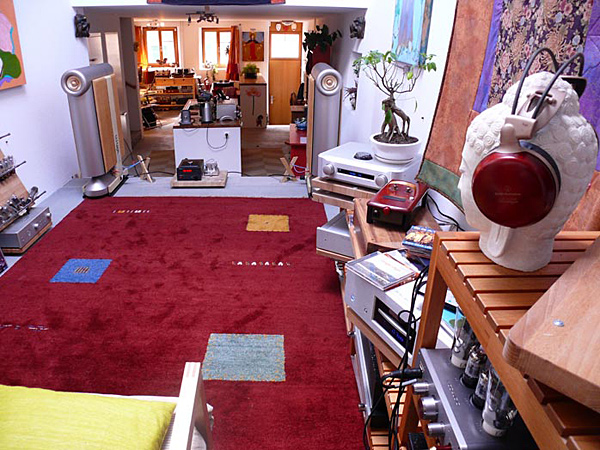 Not only was the MiniWatt quiet -- I've heard more than one elitist 45 or 2A3 amp noisier which most SET fanciers would still consider perfectly acceptable - it drove the proverbial snot out of this rig. 10:00 on the dial was pretty much the ceiling of what goes for "loud but just right" around here. Suffice to say you could hurt yourself with the MiniWatt in this setup. Was it more than a silly stunt though? Or was it just proving a point to the kilo-watt brigade who view such concepts and those who'd even contemplate them sad and lost causes? It sounded real good. The MiniWatt reminded me of the crystalline, fast as a whip, lit up EL84 Decware sound. After the stupendous Crayon Audio CFA-1, this was the second amp in recent memory to sport a switch-mode power supply where the audible results made a very strong sonic (and not cash-saving) argument in favor of abdicating conventional solutions. With a very low noise floor and apparently very high rise times, this recipe can net a very fast, detailed sound that's not dry, chalky or relentlessly transient occupied at all but rather, color intense. And very impressive in the bass. There was clearly more to MiniWatt than cuteness and miniaturization. 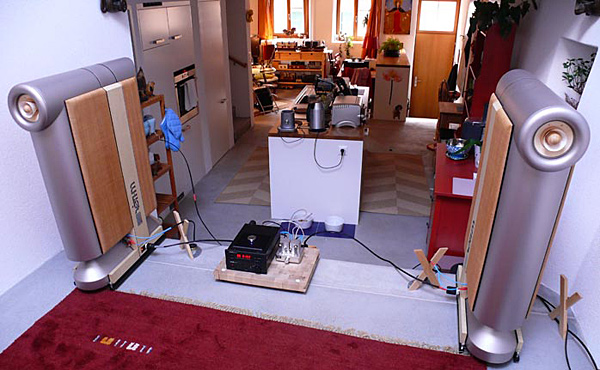 Those who've heard thin solid-core treated silver cables in minimum dielectric will have a good handle on the MiniWatt effect. It's taut, brilliant, incisive, articulate, agile and the opposite of sluggish and distanced. While speed, transparency and color interfaced exceptionally well with the Saadhana, the lit-up leanish ingredient of the density equation didn't equally. This speaker is a demanding mistress who thrives on reflexes and density. The MiniWatt supplied the first like a champion sprinter but ultimately not enough fleshiness. 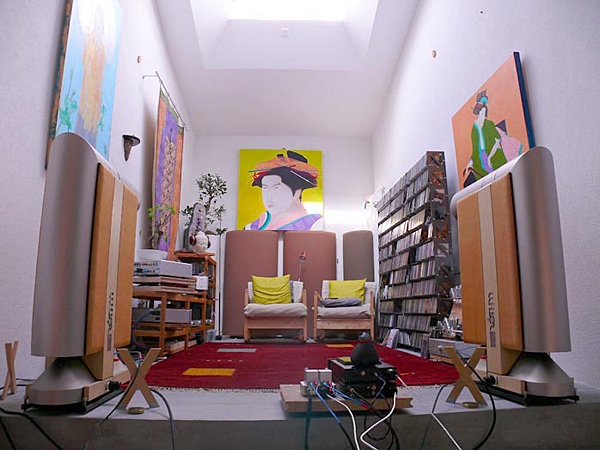 A few twirls on the controls of the active woofer sections (not for amplitude but low-pass frequency) could of course already shift this balance. Considering MiniWatt's pricing, I simply didn't think that tweaking/voicing would be on the menu of most prospective punters however. I thus refrained. Having cleared the noise hurdle with room to spare (no nasty turn-on/off transients either); and recalling an established quality competitor like Decware on performance; it was time to downscale speaker expenditure. Get just a little closer to reason. Zu's €5,000 Essence shaved off 50% and deleted active bass systems to adjudge the mini amp's own bass chops. 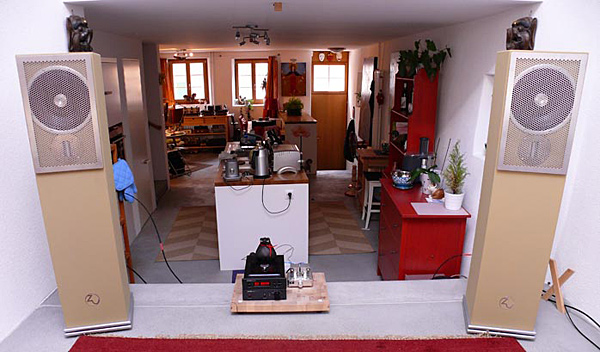 Act N°2. The Zu's far greater in-built density and far from extreme resolution in the upper midrange coupled to real low-down grunt made for one of those dream gigs one couldn't possibly predict on paper. Though specified at 97dB (i.e. just one 1dB less than the Lowther DX55), equivalent listening levels occurred two hours later, at noon in most cases, at 1:00 for happy hour. So I still had mondo headroom. On "Jan Garbarek the second", Andy Sheppard's outstanding Movements in Colour album [ECM 2062], MiniWatt had sufficient resolution to show how two different upsampling modes and none on the April Music Stello converter affected soundstaging in obvious ways and even shifted the degree of audible reed spittle on the sax. No upsampling sounded best. On Jacques Loussier's must-own The 50th Anniversary Recording [Telarc 83693], the only thing MiniMax lacked was ultimate weight on the left-handed power cords of the piano. As Mercan Dede's Nefes collaborated [Double Moon 033], bass extension itself was quite prodigious. Nothing went missing. It was a bit of amplitude crunch that began to shelf off sooner than with real muscle amps. But hang on to your hats when Dede brings in the massive bass drums on "Huo" while you've got the volume pushed beyond normal. You wouldn't believe what this combo is capable of without caving in at the knees. As the Saadhana had already indicated, the MiniWatt circuit/tubes have that snap, crackle and pop thing of expert timing in their pocket. Everything is truly articulate, springy and firm. By the time you get to truly emotive vocals like Falete does on the scorching Coplas Que Non Han Matao [Columbia, Sony|BMG], you grudgingly admit that despite a footprint smaller than a CD cover, the MiniWatt is a serious piece of bonsai audio, not a ridiculous toy. It tracks encoded energy. It's the earlier crystalline descriptor which cleans out the cobwebs and rushes on the musical waters a bit like a caffeine injection. That's perhaps the pentode contribution. It works like a hot knife through butter. There's clear similarities to EL84s but this MiniMax sound stream sloughs off particles and sediment even more. It's all very direct, very extended, on the beat and bereft of even the slightest comfort cushion of fattiness. The Essence contributed that cushion and presto, high compatibility.  Act N°3. To get more real not on the money but sensitivity meter, my DeVore Fidelity Nines were next. The small 12wpc NuForce Icon drives them well. The reasonable gain of the MiniMax and its feisty showing on the Essence (particularly unexpected in the bass) suggested another possible scenario. Besides uncertainty on ultimate SPL satisfaction however, I also harbored doubts whether the Nines' leaner self nature would cotton as hard to the Chinese amp. 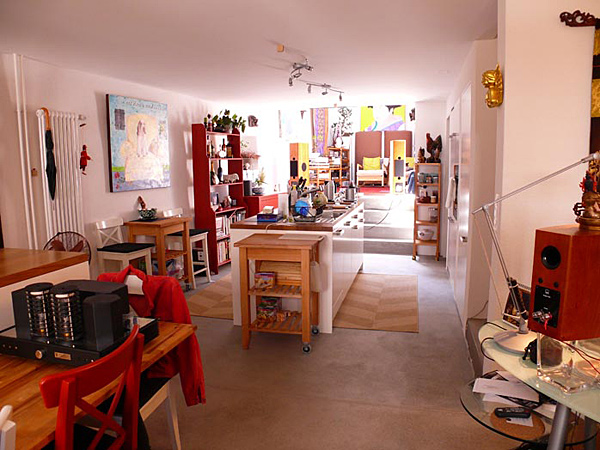 Those doubts proved unfounded. Sitting by now around 2:30 for the usual volumes, one must factor in the vast area behind the speakers. In a standard 12' x 18' or 16' x 24' space, room gain would back off the volume a few notches to probably about 1:00. So much for actual power consumption myths. Puja prince Jai Uttal rocked out Samba style on his newest (and very different) Thunder Love and perennial fave Dulce Pontes was her usual charming self on Lagrimas. Very much unlike my running criticisms on the DeVore Nines' propensity for sounding very linear and resolved but also a bit subdued in the excitement and color ranges, this pairing was most agreeable. Unexpected but very welcome. Though clearly lit up (roof down, major sunlight falling in), the DeVores did not lack for any color and bass had real growl. I was back in time and with the Crayon CFA-1. It had equally excellent holography, layering, superbly pitched muscular bass and color intensity. I was becoming fully convinced that here the SMPS was the secret weapon. I'd just never heard one with tubes before. Regardless of speaker - and as it should be if one isn't deaf yet nor suffers serious incompatibility issues - MiniWatt proved to have a recognizable signature comprised of an energetic midband, grippy bass, expanded treble and an emphasis on speed, timing and definition to sit on the far side of romance, soft focus, glow, mellifluousness and Indian summer spiderwebs wafting on the breeze. One more experiment remained on the 3rd floor, my wife's artist loft and her custom lacquer Zu Druid Credenzas. They are usually driven from a ModWright 9.0SE/AudioSector Patek SE combo. 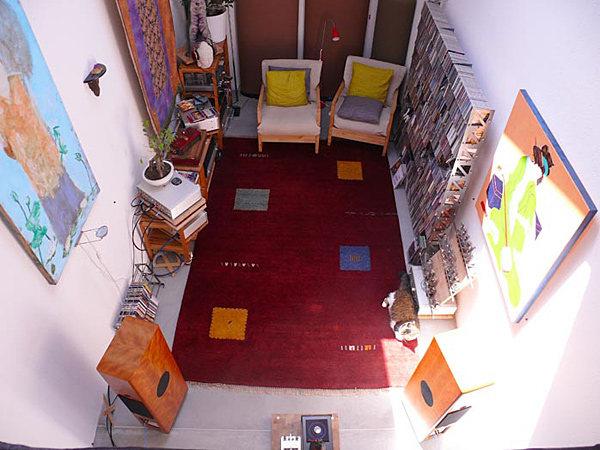 That's a nice $2,200 remote-controlled tube preamp and a 50-watt 47lab-style 'gainclone' chip amp for $1,800. The latter and its power supply sit behind the Ikea credenza, a Raysonic CD128 as source atop the ModWright preamp on the credenza and between the speakers. The space is open, with a vaulted ceiling, an open staircase connecting this floor to the two lower ones and a second desk in the right alcove adjacent to the steps (lower right photo below - that desk faces the visible one and sits right next to the just visible water bottle). In short, not a puny closet but reasonably sized space. 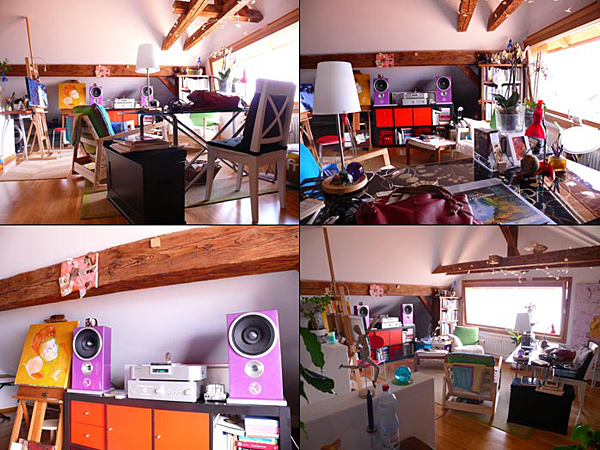 Act N°4. At 10:00 on the dial even on mellow classical, MiniWatt did all the ear-bleeding damage my wife wanted (I could have stood another hour or so more but like all women, Ivette considers me a brute when it comes to SPLs). The shocker? MiniWatt was clearly more colorful, palpable, stimulating and entertaining than the resident $4,000 two-box combo from before. On specs and wallet, this was all wrong; but not to our four ears. On such messy occasions, who do you listen to? Sometimes one just shuts up and puts up with one's blessings unquestioned. Who needs explanations? 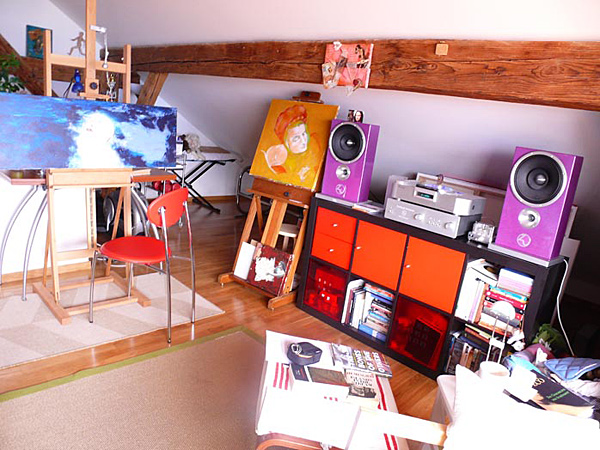 Interlude in the dressing room. Imagine this circuit doubled up twice, i.e. paralleled and monoblocked. At 20-or-so watts with four output valves per side in class A push/pull, this could become positively scary for some of the bigger boys. Of course we'd probably be up to $800 - $1,000 to nix the special appeal of what the MiniWatt crew actually did create. A thought for next year perhaps? Never mind, available today as a baby Crayon, the MiniWatt is a very clever marriage of tubes and switch-mode power supply, of ancient and new. Tarted up with blue lights and chrome, scaled up to be heavier and bigger, the MiniWatt could be marketed as the smart man's alternative to direct-heated 45s. As is, necessity will only have the budget challenged take it serious. C'est la vie. 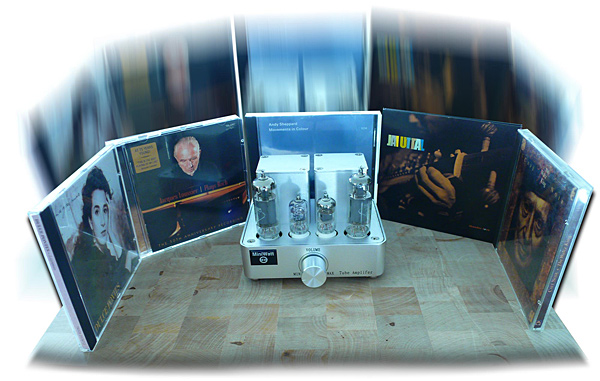 Grand finale & curtain call. Reader John Walton in Germany who purchased my original black pair of Zu Essence loaners from the Utah gang: " Really enjoying the as I call it turbo Bentley sound of the Essence. My source is MWI Sony-9100, tube 9.0 & Zu cables. I'm still playing with amps (Gryphon Tabu Century, Ampino, RWA Sig30 with Promitheus TVC & active tube) and still prefer my Gryphon overall. I prefer the Ampino to the RWA/Promitheus (the pre-combo is quite amazingly good regardless of its low price). BTW, Mr. Dayens wrote that he's bringing out mono Ampinos later this year - balanced? Modern day NAD3020; Zoran has good ears - I am so glad you found him. I'm doing what little I can to bring up the Dayens name in my correspondences. My stereo soft-touch technician friend Christian Schulz (makes the electronics e.g. Martion horns) writes that '...for the money the Ampino looks real mature. Must be close to raw build cost, at a measly €3 per hour wages'."  The MiniWatt is to tubes what the Dayens Ampino is to transistors - a wake up call to the competition; a whiff of Crayon flavor to the Ampino's mini FirstWatt aroma; a would-be thorn in the side of the apostles of excess both power and money; and a golden opportunity for those short on funds, high on audiophile ambitions and self-secure enough to disregard the Joneses and Musical Fidelity's Titan. Obviously this isn't the amp for collateral damage and rock-arena youngsters whose hearing is still immortal. It's also got no power credibility. But don't shortchange its application to 1-meter desk top coverage only. It's clearly capable of energizing a conservatively sized room in the midfield over 92dB impedance-friendly floorstanders without colossal bass arrays. Something from the Canadians at Axiom selling for $500 to $800 could be ideal. I think you get the picture. It's called realsization. And it's not a matter of belief but practice. Srajan Ebaen PS: All reviewers serious about their craft should own both an Ampino and MiniWatt. These pups really keep you honest and your feet of perspective planted on terra firma relevantia.  Quality of packing: Delivered in PostPack box, then internally cradled in full-contact foam. CDs FROM JAPAN  |
||
| © Copyright HIGH Fidelity 2009, Created by B |
